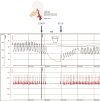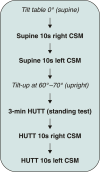Carotid sinus massage in clinical practice: the Six-Step-Method
- PMID: 39397761
- PMCID: PMC11544318
- DOI: 10.1093/europace/euae266
Carotid sinus massage in clinical practice: the Six-Step-Method
Abstract
Carotid sinus massage (CSM) as integral part of cardiovascular autonomic testing is indicated in all patients > 40 years with syncope of unknown origin and suspected reflex mechanism. However, large practice variation exists in performing CSM that inevitably affects the positivity rate of the test and may result in an inaccurate diagnosis in patients with unexplained syncope. Even though CSM was introduced into medical practice more than 100 years ago, the method of performing CSM is still largely operator- and centre-dependent, while in many places, the test has been entirely abandoned. Here, we describe a standardized protocol on how to perform CSM, which basic monitoring equipment is necessary and why CSM is a safe procedure to perform. Our aim is to create a uniform approach to perform CSM. The new proposed algorithm, the Six-Step-Method, includes: (i) check history for exclusion CSM; (ii) turn head slightly contralaterally and posterior (see also explanatory video and poster provided as Supplementary material; (iii) palpation to identify carotid sinus location; (iv) massage for 10 s; (v) monitoring of blood pressure and heart rate to assess of the haemodynamic response type; and (vi) include time intervals between subsequent massages. Carotid sinus massage should be performed on both the left and right and in the supine and upright position. The recommended equipment to perform CSM consists of: (i) a tilt table in order to perform CSM in supine and standing position, (ii) a continuous blood pressure monitor or cardiac monitor, and (iii) at least two persons.
Keywords: Carotid sinus massage; Haemodynamic monitoring; Syncope; Tilt table testing; Video recording.
© The Author(s) 2024. Published by Oxford University Press on behalf of the European Society of Cardiology.
Conflict of interest statement
Conflict of interest: none declared.
Figures





Comment in
-
Carotid sinus massage in clinical practice.Europace. 2025 Mar 28;27(4):euaf058. doi: 10.1093/europace/euaf058. Europace. 2025. PMID: 40101146 Free PMC article. No abstract available.
Similar articles
-
Mechanism of syncope: role of ambulatory blood pressure monitoring and cardiovascular autonomic function assessment.Eur Heart J. 2025 Mar 3;46(9):827-835. doi: 10.1093/eurheartj/ehae907. Eur Heart J. 2025. PMID: 39786439 Free PMC article.
-
Abnormal cardiovascular responses to carotid sinus massage also occur in vasovagal syncope - implications for diagnosis and treatment.Eur J Neurol. 2010 Aug;17(8):1061-7. doi: 10.1111/j.1468-1331.2010.03006.x. Epub 2010 Apr 8. Eur J Neurol. 2010. PMID: 20402752
-
An abnormal neural reflex plays a role in causing syncope in sinus bradycardia.J Am Coll Cardiol. 1993 Oct;22(4):1130-4. doi: 10.1016/0735-1097(93)90427-3. J Am Coll Cardiol. 1993. PMID: 8409052
-
Usefulness of Tilt Testing and Carotid Sinus Massage for Evaluating Reflex Syncope.Am J Cardiol. 2018 Aug 1;122(3):517-520. doi: 10.1016/j.amjcard.2018.04.033. Epub 2018 May 1. Am J Cardiol. 2018. PMID: 29954601 Review.
-
Clinical laboratory testing: what is the role of tilt-table testing, active standing test, carotid massage, electrophysiological testing and ATP test in the syncope evaluation?Prog Cardiovasc Dis. 2013 Jan-Feb;55(4):418-24. doi: 10.1016/j.pcad.2012.11.002. Prog Cardiovasc Dis. 2013. PMID: 23472780 Review.
Cited by
-
Pathophysiological aspects of carotid sinus massage.Europace. 2025 Mar 28;27(4):euaf047. doi: 10.1093/europace/euaf047. Europace. 2025. PMID: 40103329 Free PMC article.
-
Did George Floyd Die of Cardioinhibition From Pressure on His Neck?Acad Forensic Pathol. 2025 Mar 29:19253621251327721. doi: 10.1177/19253621251327721. Online ahead of print. Acad Forensic Pathol. 2025. PMID: 40171072 Free PMC article.
-
Carotid sinus massage in clinical practice.Europace. 2025 Mar 28;27(4):euaf058. doi: 10.1093/europace/euaf058. Europace. 2025. PMID: 40101146 Free PMC article. No abstract available.
References
-
- Brignole M, Moya A, de Lange FJ, Deharo JC, Elliott PM, Fanciulli Aet al. . 2018 ESC guidelines for the diagnosis and management of syncope. Eur Heart J 2018;39:1883–948. - PubMed
-
- Kerr SR, Pearce MS, Brayne C, Davis RJ, Kenny RA. Carotid sinus hypersensitivity in asymptomatic older persons: implications for diagnosis of syncope and falls. Arch Intern Med 2006;166:515–20. - PubMed
-
- Puggioni E, Guiducci V, Brignole M, Menozzi C, Oddone D, Donateo Pet al. . Results and complications of the carotid sinus massage performed according to the “method of symptoms”. Am J Cardiol 2002;89:599–601. - PubMed
-
- Brignole M, Gigli G, Altomonte F, Barra M, Sartore B, Prato Ret al. . Il riflesso cardioinibitore provocato dalla stimolazione del seno carotideo nei soggetti normali e con malattie cardiovascolari [Cardioinhibitory reflex provoked by stimulation of carotid sinus in normal subjects and those with cardiovascular disease]. G Ital Cardiol 1985;15:514–9. - PubMed
Publication types
MeSH terms
LinkOut - more resources
Full Text Sources

